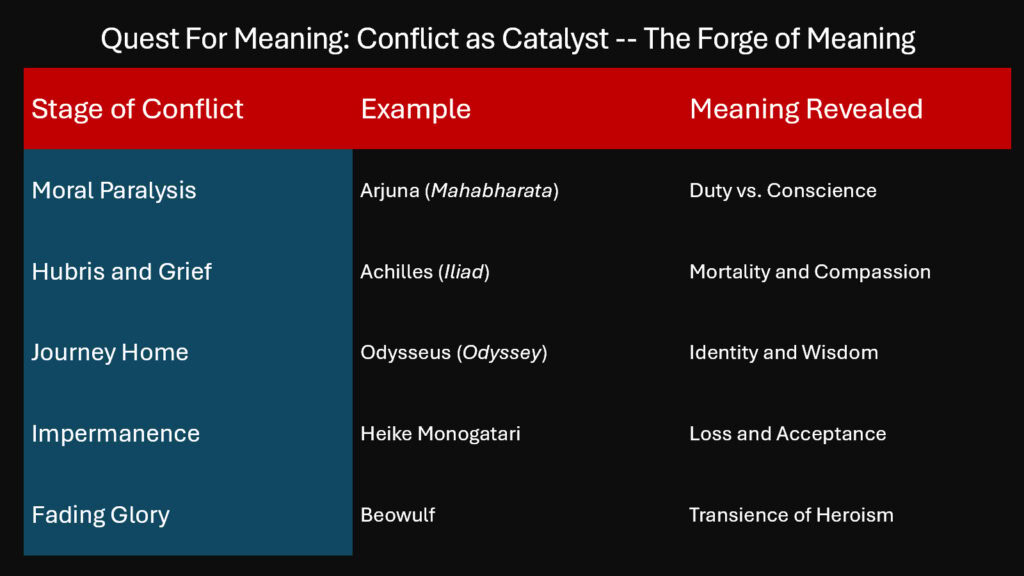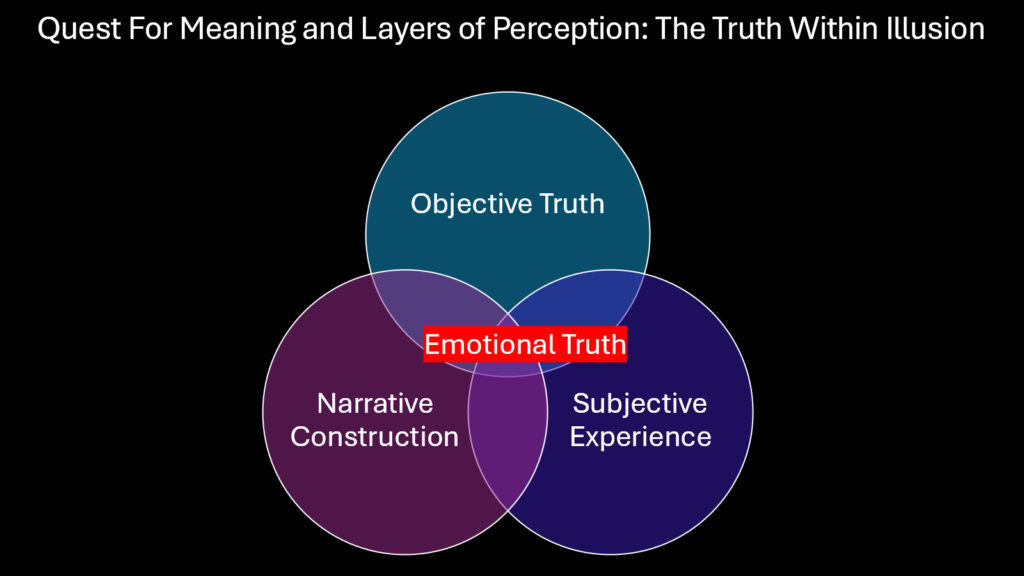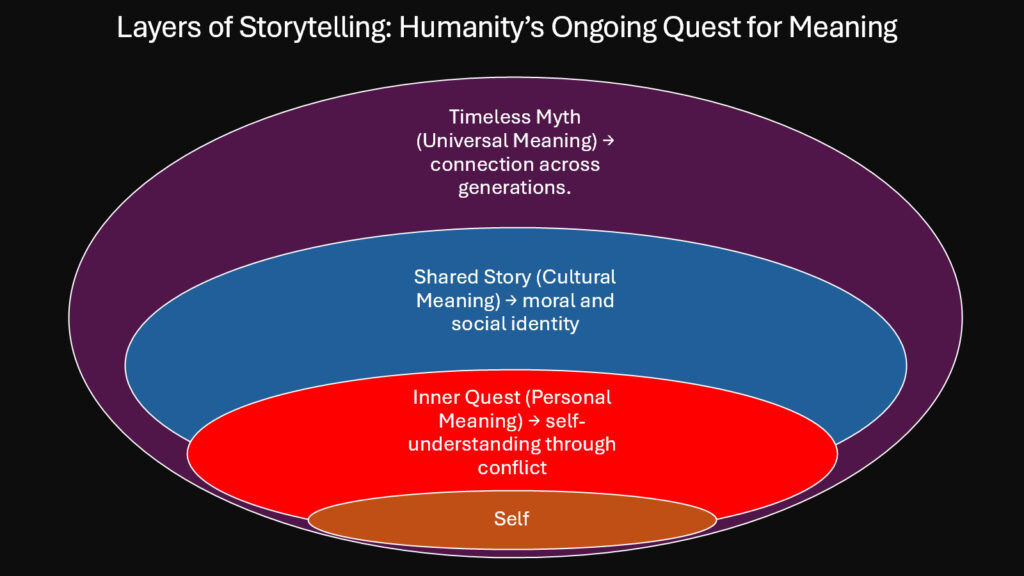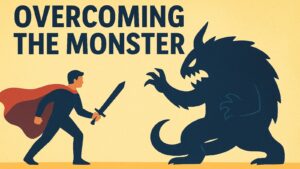Table of Contents
Introduction: The Timeless Quest for Meaning in Every Story

Every great story begins with a search. A boy stands before his father’s body in the African savanna, wrestling with grief and guilt. A sailor clings to wreckage in the Pacific, floating between survival and surrender. An ancient king blinds himself after learning a terrible truth. These moments capture something essential about human existence—the Quest for Meaning, one of the most important story archetypes that has shaped narratives across cultures and centuries.
Stories do more than entertain. They transform how we see ourselves and the world around us. Through narrative, we chase purpose, confront truth, and search for emotional resolution. This archetypal journey appears in myths whispered around prehistoric fires and blockbuster films projected onto silver screens.
Consider Odysseus, battering through storms for ten years to reach Ithaca and understand who he has become. Or Simba in The Lion King, fleeing into exile before discovering his true identity. Or Pi Patel in Life of Pi, constructing meaning from chaos on a lifeboat. Each narrative pulls us into a fundamental human experience—the search for something that makes existence worthwhile.
This archetype operates differently than others. While some stories focus on external achievement or survival, the Quest for Meaning turns inward. It examines belief, identity, and collective memory. The hero does not simply defeat a monster or gain wealth. Instead, they discover truth that reshapes everything they thought they knew.
The following exploration examines six powerful ways this archetype transforms storytelling. From the initial call to transformation through conflict, memory, perception, empathy, and beyond the ending, we trace how stories help us make sense of existence.
Comparison of Quest for Meaning with Other Story Archetypes
| Story Archetypes | Core Focus and Journey |
|---|---|
| Quest for Meaning | Character seeks purpose and truth through internal transformation and philosophical discovery |
| Rags to Riches | Character rises from poverty to wealth and success through effort or fortune |
| Overcoming the Monster | Hero confronts and defeats an external threat that endangers their world |
| Voyage and Return | Character travels to unfamiliar territory and returns home changed |
| Power of Connection | Character discovers strength through relationships that redefine their identity |
| Rebirth and Revelation | Character undergoes psychological death and resurrection with renewed perspective |
1. Quest for Meaning Begins: The Call to Transformation
The hero sits in comfort, unaware that everything is about to change. Stories ignite when a character steps beyond what they know, seeking truth or redemption. The Quest for Meaning mirrors our inner search for purpose, pulling readers into a journey that feels both universal and deeply personal.
Writers craft this call to adventure with precision. A letter arrives. A murder disrupts peace. A dream refuses to fade. These narrative hooks do more than create conflict—they awaken desire for understanding. The character cannot remain unchanged. Something essential has been disturbed, and only transformation can restore balance.
Hamlet receives news of his father’s ghost. Neo discovers the Matrix. Harry Potter learns he is a wizard. Each call disrupts ordinary existence and suggests that surface reality conceals deeper meaning. The character faces a choice—remain in comfortable ignorance or pursue uncomfortable truth. This decision resonates because we all face similar crossroads in life.
The early stages establish what the character believes about the world. These beliefs will be tested, shattered, and rebuilt. A young protagonist might assume justice always prevails or that suffering serves no purpose. The story will challenge these assumptions through experience and revelation. Meaning emerges not from having answers but from asking better questions.
Writers intensify this call through mystery and desire. What really happened that night? Why did my mentor betray me? What makes a life worth living? These questions drive the narrative forward while reflecting the audience’s yearning for purpose. The character becomes a proxy for our own search.
The call to transformation taps into something primal. Humans are meaning-making creatures. We construct narratives to explain suffering and connect isolated experiences into coherent patterns. When a story begins this quest, it activates our deepest psychological drives. We lean forward, invested in the outcome, because we too are searching for answers that make existence comprehensible.
Elements That Launch the Quest for Meaning
| Narrative Element | Role in Initiating Transformation |
|---|---|
| Disruption of Normalcy | Shatters the character’s ordinary world and comfortable assumptions |
| Awakening of Questions | Plants seeds of doubt that grow into pursuit of deeper truth |
| Mysterious Revelation | Introduces information suggesting hidden dimensions requiring exploration |
| Moral Crisis | Forces character to confront inadequacy of their current worldview |
| Guidance or Prophecy | Offers cryptic direction hinting at significance beyond immediate circumstances |
| Refusal and Acceptance | Shows character’s resistance before commitment, making eventual choice meaningful |
2. Quest for Meaning Through Conflict and Doubt

True transformation does not arrive through easy revelation. Instead, meaning emerges from wrestling with conflict, doubt, and moral uncertainty. Ancient epics understood this principle deeply, crafting heroes who found truth not despite struggle but because of it.
The Mahabharata presents Arjuna frozen on the battlefield, confused by moral doubt. He faces his cousins in combat, questioning whether duty justifies such violence. This conflict forces him to examine the nature of righteousness and obligation. His transformation comes through confronting these impossible questions, not from receiving simple answers.
Consider the Iliad, where Achilles rages against fate and mortality. His pride drives him to withdraw from battle, letting his comrades die. Only after losing Patroclus does he confront the emptiness of his anger. Meaning arrives through devastating loss, teaching him that glory without love leaves nothing behind.
The Odyssey follows a different path. Odysseus journeys home while struggling against divine punishment and his own flaws. Each island presents new challenges that test his understanding of identity and belonging. He descends into the underworld, confronts his past, and slowly learns that cleverness alone cannot substitute for wisdom.
The Heike Monogatari chronicles the fall of the Taira clan, exploring how power and pride lead to destruction. Characters wrestle with fate and loyalty. Meaning emerges not from victory but from accepting transience. The narrative suggests that true understanding requires embracing uncertainty rather than conquering it.
These ancient stories share a crucial insight—meaning is not found in the absence of conflict but born from enduring it. Heroes transform precisely because they face moral struggle and questions that have no perfect answers. Doubt serves as a catalyst rather than an obstacle. When a character questions their purpose, they open themselves to transformation.
How Ancient Epics Explore Meaning Through Struggle
| Epic Narrative | Central Conflict That Generates Meaning |
|---|---|
| Mahabharata | Arjuna’s confusion before battle forces examination of duty and righteousness |
| Iliad | Achilles confronts mortality and pride, learning that rage destroys everything |
| Odyssey | Odysseus endures exile, discovering that identity requires more than cleverness |
| Heike Monogatari | Fall of the Taira clan reveals how power leads to suffering and impermanence |
| Aeneid | Aeneas struggles between personal desire and destiny through sacrifice |
| Epic of Gilgamesh | Confrontation with mortality drives search for eternal truth |
3. Quest for Meaning in Memory and Reflection
Stories gain depth when characters pause to look backward. Memory becomes more than nostalgia—it transforms into a tool for understanding. Through flashbacks and introspection, narratives reveal how past experiences shape present meaning.
Consider how films use this approach. A character sits alone, and the camera drifts into recollection. We see the moment everything changed—a betrayal, a loss, a choice that cannot be unmade. These scenes show how the character has been interpreting their life, what beliefs they formed from experience, and why certain truths remain hidden.
Writers understand that healing moves through remembrance. A soldier cannot process war without confronting what happened in combat. A parent cannot forgive themselves without examining the moment they failed their child. The Quest for Meaning demands this backward glance because transformation requires acknowledging where we have been.
Flashbacks reveal the gap between what happened and what the character believes happened. Perhaps a hero remembers abandonment, but the flashback shows love expressed clumsily. Perhaps a villain recalls injustice that justified their rage, but the memory reveals their own role. These moments force both character and audience to reconsider established interpretations.
Introspection works differently than action but carries equal weight. A character sits by a fire or walks alone through rain. During these quiet moments, the internal journey becomes visible. Questions surface. Doubts crystallize. The character begins to see their life as a story rather than random events, finding threads that connect disparate experiences into something coherent.
The most powerful stories show that meaning is not fixed. As characters gain wisdom, their past takes on new significance. What seemed like failure becomes necessary preparation. Memory becomes fluid rather than static, allowing transformation to reach backward and forward simultaneously.
How Memory Shapes the Quest for Meaning in Storytelling
| Memory Technique | Function in Character Transformation |
|---|---|
| Revealing Flashback | Shows past event that contradicts character’s understanding, forcing reinterpretation |
| Traumatic Recollection | Exposes unprocessed wound that blocks growth until acknowledged |
| Nostalgic Contrast | Highlights how much has changed, making character recognize distance traveled |
| Fragmented Memory | Reflects confused understanding that gradually coheres as character gains wisdom |
| Shared Memory | Connects character to others through common experience, building empathy |
| Recontextualized Past | Allows character to see old events through new perspective, changing their meaning |
4. Quest for Meaning in Truth and Perception

Reality shifts depending on who tells the story. This simple truth opens profound narrative possibilities. The Quest for Meaning often involves discovering that what we believed was incomplete or deliberately concealed. Writers use unreliable narrators and shifting perspectives to explore how meaning emerges from emotional honesty.
Consider stories told from fractured viewpoints. Each character believes their version completely, yet contradictions pile up. A murder looks like self-defense from one angle and cold-blooded killing from another. These narratives suggest that meaning lives in interpretation rather than fact.
The unreliable narrator serves the Quest for Meaning perfectly. When a storyteller admits their confusion or reveals their bias, they acknowledge that certainty is illusion. This admission invites deeper engagement. The audience must work to separate fact from interpretation, becoming active participants in meaning-making rather than passive receivers.
Films and novels use this technique to mirror human experience. We all narrate our lives from limited perspective. We emphasize certain details while forgetting others. Stories that acknowledge this tendency feel more honest than those claiming omniscient clarity. They admit what philosophy has long known—truth is slippery, and meaning is something we create rather than discover.
This approach also explores how confusion can reveal emotional truth. A character might misremember events, but their distortions expose what matters to them. Fear reshapes memory one way, guilt another. The Quest for Meaning becomes about understanding why we tell ourselves certain stories, not just whether those stories are accurate.
Writers who master this technique create stories that linger long after the final page. They plant doubt without providing easy resolution. They show multiple truths coexisting, each valid from its own angle. The Quest for Meaning thrives in this uncertain space, where transformation comes from learning to live with questions rather than demanding answers.
How Perspective Shapes the Search for Meaning
| Narrative Perspective | Impact on Quest for Truth and Meaning |
|---|---|
| Unreliable Narrator | Forces audience to question surface interpretation and construct understanding |
| Multiple Viewpoints | Reveals how same events generate different meanings depending on experience |
| Stream of Consciousness | Exposes raw thoughts before interpretation, showing how meaning forms in real time |
| Limited Knowledge | Creates gap between what happened and what character knows, building mystery |
| Biased Recollection | Demonstrates how emotion and identity distort memory toward self-protection |
| Gradual Revelation | Parcels out truth slowly, allowing character to adjust understanding progressively |
5. Quest for Meaning Through Connection and Empathy
Stories unite people by revealing shared struggles. When a character searches for meaning, they often discover it through connection with others. The hero’s quest includes descent into isolation and eventual return to community, carrying insight gained from transformation.
Empathy serves as a bridge across difference. A story lets us inhabit another consciousness, experiencing their pain, hope, and revelation. We feel what the character feels, adjusting our perspective to accommodate theirs. This process transforms both character and audience, building capacity for understanding that extends beyond the narrative.
Consider how stories teach moral realization through relationship. A hardened warrior meets a child who reminds him of innocence lost. A cynical executive encounters someone whose suffering she previously ignored. These connections crack open hardened hearts, allowing new meaning to take root. The character cannot complete their transformation alone—they need others to mirror back their growth.
Writers structure this through the return phase of the hero’s journey. After venturing into darkness and gaining wisdom, the hero must bring that wisdom home. They share what they learned, healing their community through transformed understanding. This return completes the Quest for Meaning by making personal insight into collective gift.
Empathy also operates between audience and character. We invest in fictional people because their struggles illuminate our own. A story about grief helps us process loss. A narrative about injustice awakens moral awareness. The character’s Quest for Meaning becomes entangled with ours, creating resonance that persists long after the story ends.
The most powerful narratives show characters learning to see beyond themselves. A quest that begins as personal gradually expands to encompass community or humanity. The character realizes their search connects them to everyone who has ever asked similar questions. This recognition transforms isolation into belonging.
How Connection Deepens the Quest for Meaning
| Relational Element | Role in Meaning and Transformation |
|---|---|
| Mentor Relationship | Provides guidance and wisdom that helps character interpret their journey |
| Mirror Character | Reflects protagonist’s qualities, illuminating patterns they cannot see alone |
| Community Belonging | Offers context and purpose beyond individual concerns |
| Healing Partnership | Creates space for vulnerability where transformation can emerge |
| Antagonist Understanding | Humanizes opposition, revealing shared desires beneath surface conflict |
| Return and Sharing | Completes transformation by converting personal insight into gift for others |
6. Quest for Meaning Beyond the Ending
True stories resist neat closure. The best narratives leave meaning alive and unresolved, suggesting that transformation continues past the final scene. Writers use circular structure, narrative echoes, and open conclusions to mirror life’s ongoing search for understanding.
Consider how circular narratives operate. The ending returns to the beginning but everything has changed. A character stands in the same place, speaks similar words, yet the meaning has transformed completely. This technique shows that wisdom comes from seeing familiar things with new eyes.
Foreshadowing and callbacks create echoes that reverberate through narrative time. An image from the opening gains significance in retrospect. A line of dialogue returns transformed by subsequent events. These repetitions emphasize how meaning accumulates rather than resolves. The story teaches us to look backward and forward simultaneously.
Open endings frustrate readers seeking resolution but honor something true about existence. Life does not wrap up neatly. Questions persist. Struggles continue. Stories that embrace this reality feel more honest than those imposing artificial completion. The character steps into uncertain future, and we step with them.
This technique serves the Quest for Meaning perfectly. If the archetype explores how we search for purpose and truth, then suggesting the search continues makes philosophical sense. Meaning is not a destination but a process, not an answer but a way of questioning.
Writers also use ambiguity to keep meaning alive. Is the ending happy or tragic? Did the character find truth or illusion? Different readers might answer differently, and that diversity reflects how meaning operates in actual experience. The story honors this multiplicity by refusing to dictate a single interpretation.
The most resonant narratives plant seeds that bloom long after reading ends. An image lingers. A question nags. A character’s choice makes us reconsider our own. These lingering effects demonstrate that the Quest for Meaning extends beyond narrative boundaries.
How Stories Continue the Quest Beyond Conclusion
| Narrative Technique | Effect on Ongoing Search for Meaning |
|---|---|
| Circular Structure | Returns to beginning with transformed perspective, showing wisdom as seeing differently |
| Echo and Callback | Creates resonance across narrative time, revealing how meaning accumulates |
| Open-Ended Resolution | Refuses false closure, honoring life’s ongoing complexity and unanswered questions |
| Ambiguous Outcome | Invites multiple interpretations, acknowledging that meaning varies by perspective |
| Unresolved Subplot | Suggests life continues with complications, maintaining realistic texture |
| Final Image or Question | Plants seed that grows in reader’s mind, extending transformation into experience |
Conclusion: The Eternal Quest for Meaning in the Human Story

All storytelling mirrors humanity’s search for meaning. Whether ancient myth or modern cinema, narratives help us understand existence by transforming chaos into pattern, suffering into purpose, confusion into insight. The Quest for Meaning stands among the most important story archetypes because it addresses fundamental human needs—to know why we are here, what matters, and how to live with integrity.
Transformation happens through the journey rather than the ending. Characters change not when they find answers but while they search for them. Conflict refines understanding. Memory provides perspective. Connection generates empathy. Truth reveals itself gradually through doubt and revision.
The hero’s journey becomes our journey. We are both narrator and seeker, telling ourselves stories while searching for better ones. Each narrative we encounter offers new lens for examining experience, fresh language for describing struggles we thought were ours alone. Through the story, we discover that our questions have been asked before, our pain felt by others.
Stories transform belief, identity, and collective memory by showing that meaning is made rather than found. We construct understanding from experience and reflection. We revise our narratives as we gain wisdom. We tell new stories to our children, passing forward the best of what we learned.
The Quest for Meaning never ends because the questions that drive it remain perpetually relevant. What makes life worthwhile? How should we face suffering? What connects us to something larger than ourselves? Stories cannot answer these questions definitively, but they can teach us how to live inside them with courage and compassion.
Consider yourself standing at the threshold, called toward a transformation you cannot yet imagine. The story has begun. The search continues. The meaning you seek is waiting not at the destination but woven into every step of the journey itself.
Core Elements of the Quest for Meaning Archetype
| Narrative Stage | Contribution to Overall Transformation |
|---|---|
| Call to Adventure | Disrupts comfort and awakens hunger for truth that propels change |
| Descent into Doubt | Strips away false certainties through conflict, forcing examination of beliefs |
| Memory and Reflection | Provides perspective on past that allows character to reinterpret their story |
| Confronting Illusion | Reveals gap between perception and reality, teaching that truth requires humility |
| Connection and Return | Transforms personal insight into shared wisdom, grounding meaning in relationship |
| Continuing Journey | Refuses false closure, acknowledging that meaning unfolds across entire lifetime |




